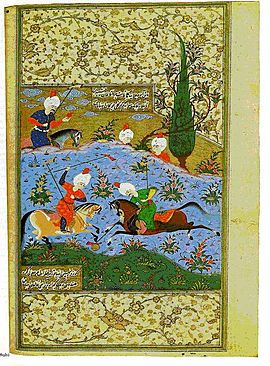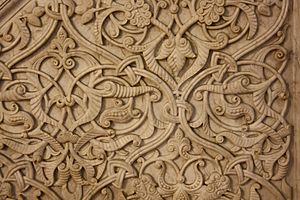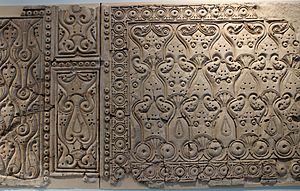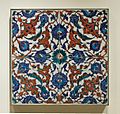Arabesque facts for kids

Arabesque is an artistic decoration. It uses "surface decorations based on... interlacing foliage, tendrils" or plain lines. Another definition is "Foliate ornament, used in the Islamic world, typically using leaves... combined with spiralling stems".
Arabesques are usually of a single design which can be 'tiled' or repeated as many times as desired.
The term "arabesque" is used as a technical term by art historians for decoration in Islamic art from about the 9th century onwards, and European decorative art from the Renaissance onwards. Note that Islamic geometric patterns are a different style from arabesques.
Images for kids
-
Part of a 15th-century ceramic panel from Samarkand (Uzbekistan) with white calligraphy on a blue arabesque background
-
The "Tellus Panel" from the Ara Pacis, in Rome, circa 27 AD. The lower part of the panel is an example of a Roman arabesque
-
Design for a Louis XVI style arabesque, by Étienne de La Vallée Poussin, circa 1780-1793, pen and gray and brown ink, brush and colored wash, in the Metropolitan Museum of Art
-
Three modes: arabesques, geometric patterns, and calligraphy used together in the Court of the Myrtles of Alhambra (Granada, Spain)
-
The French sense of arabesque: a Savonnerie carpet in the Louis XIV style, circa 1685-1697, made of wool, in the Metropolitan Museum of Art (New York City)
-
What is called the "Arabesque Room" in the Catherine Palace, with neoclassical grotesque decoration
-
Mosaics on the Treasury Dome of the Great Mosque of Damascus, 789, still in essentially Byzantine style
-
Ivory pyxid, 10th century, in the Louvre
-
Panel with horse heads, 11th century, in the Metropolitan Museum of Art (New York City)
-
Ottoman tughra of Suleiman the Magnificent, with flowers and saz leaves, 1520
-
Iznik tiled lunette panel that may have come from the Piyale Pasha Mosque in Istanbul, 1570-1575, in the Victoria and Albert Museum from London
-
French arabesque garden planting at Vaux-le-Vicomte, in low box hedges on pink gravel
-
French 18th century Neoclassical grotesque decor at Chateau de Fontainebleau; this would probably have been described as arabesque by its makers
-
Neoclassical arabesques in the Tullgarn Palace from Sweden
-
Renaissance Revival cast iron door window grill of a building on the Boulevard du Temple from Paris
-
Arabesque with a mascaron and a cartouche, on a façade of an 1890s or 1900s city-house from Bucharest
-
Art Nouveau arabesque on a façade of a city-house from Bucharest
See also
 In Spanish: Arabesco para niños
In Spanish: Arabesco para niños




























